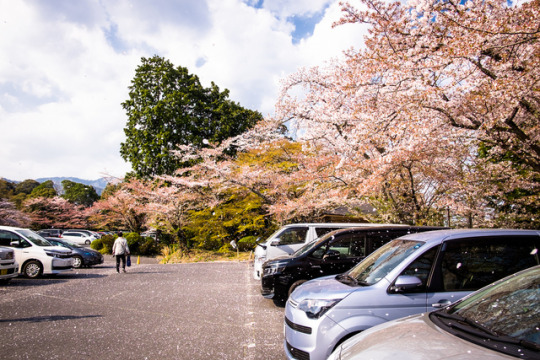#mii-dera
Note
so like, we know animal youkai don't live that long (less than a century in most cases) then how is mouse sensei here one of the oldest teacher even back before hiyaki academy??
because the tesso isn't an animal youkai; it's a grudge youkai
the story of the tesso goes, during the reign of emperor shirakawa (1073-1087 CE) there was a monk named raigou who was the abbot of mii-dera
the emperor asked raigou to pray for the birth of an heir and promised him any reward, raigou complied, and he had a prince in 1074. but when raigou asked for a new ordination platform be built for his temple, rival temple enryaku-ji pressured the emperor and the emperor went back on his promise.
raigou went on a hunger strike to protest the emperor's broken promise and to drag the prince down. he died on the 100th day and later his ghost was seen near the prince, who died at age 4. raigou died so resentful that he became a vengeful spirit and transformed into a giant rat with a body hard as stone and teeth and claws hard as iron, and summoned a massive army of rats that poured through kyoto, up mount hiei, to wreak havoc at enryaku-ji, and nothing could stop tesso and his rat army until a shrine was built at mii-dera to appease him.
so there is actually a difference between the tesso and other animal youkai, in that the tesso is a specific story, and most animal youkai are "animals but weird"
(just kidding i dont actually know why mouse sensei built different. because its funny maybe?)
(this was a super abridged version of the tesso story read more here)
44 notes
·
View notes
Text
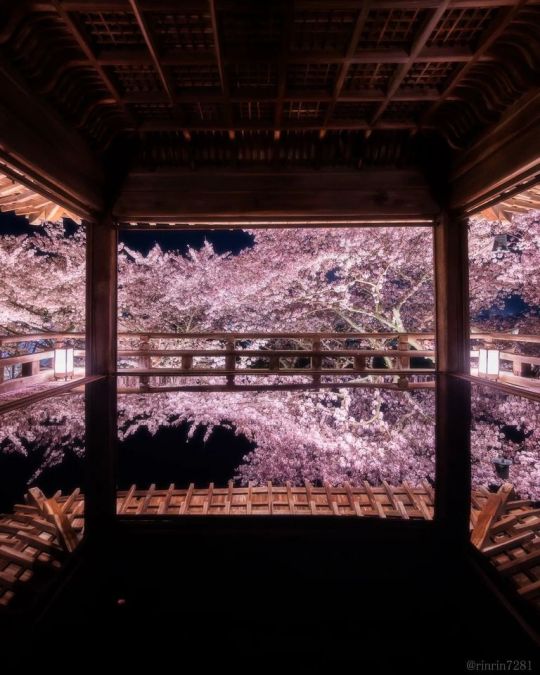
Cherry blossom reflection at Mii-dera Temple in Otsu, Shiga Prefecture. This beautiful Buddhist temple is located at the foot of Mount Hiei, not far from Kyoto.
Photo by rinrin7281
41 notes
·
View notes
Text
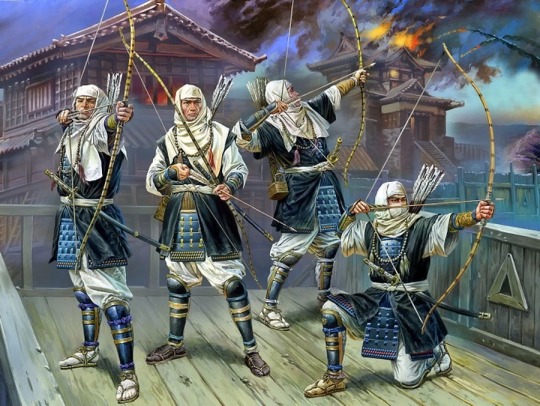
From a bad translation, Russian to English. Unedited because I’m too lazy.😁🤷🏽
SOHEI - BUDDHIST WARRIORS OF ANCIENT JAPAN
Sohei ( дат Sohei, literally "monk-soldier") - Buddhist warrior monks of feudal Japan. At certain points in history, they had considerable power, thus forcing imperial and military governments to cooperate.
They were similar to the mountain ascetes of yamabushi, but unlike the yamabushi hermits, the soheis were usually organized into large armies or units. Most famous is their Enryaku-ji Monastery on Mount Heei, not far from Kyoto.
Many common traits the Soheis had with warrior monks from Germany or other religious orders (for example, such as participating in a crusade; the Soheis did not operate as individuals or even as members of individual temples, but rather as warriors of the Great Brotherhood or monastic order).
Warrior monks first “claimed themselves” in the late 10th century, in the Heian era, during fierce political disputes between Buddhist temples and sects over receiving various titles from the emperor. The main confrontation took place in the area of Kyoto and Nara cities, in Japan's 4 largest temples - Todai-ji, Kofuku-ji, Mii-dera and Enryaku-ji.
The first armed encounter occurred in 949. , when 56 monks from Todai-ji came out to the Imperial Palace in Kyoto to protest against their inconvenient assignment. These kinds of performances lasted throughout the 10th century and often ended in a murder.
Since 981 Clashes began between the 2 main temples of the Tendai Buddhist sect - Enryaku-ji and Mii-dera. Armed clashes between these temples lasted with breaks throughout the 11th century and early XII. Along with the armies, violence has also increased. Sometimes it even came to the burning of an unfriendly residence. Other temples were also gradually involved in conflicts, joining forces with yesterday's enemies to confront other temples.
A prolonged civil war began in Japan at the end of the 12th century. Temples distracted themselves from constant windows, observing events happening in the country. Hostile houses of Minamoto and Tyra tried to persuade warrior monks of Kyoto and Nara to replenish their samurai armies. The Sohei claimed themselves in 1180, when the Mi-dera monks along with the samurai of the Minamoto house tried to protect the bridge across the Uji River from the invasion of Tyra troops. During this battle, known as the Battle of Uji, the monks disassembled the pillars of the bridge so that the horse samurai could not cross the river.
After the Gampay war, many monasteries began to reform. Their political power grew generally in peaceful ways, and the Soheis almost did not participate in the battles of the 13th-XIV centuries. During the wars of the Nambokuteo-era, Mount Hyei gave refuge to the rebellious Emperor Go-Daigo. With his son and soheis, he tried to gather forces for a short-term rebellion against the Kamakura shogunate. After this, another military government, the Asikaga shogunate, came to power, bringing an end to the restoration of Kammu. The new shogunate supported the Zen sect more than others, and therefore attracted the wrath of warrior monks. From 1340 to 1360, many clashes occurred between the temples of the Zen and Tendai sect.
The Onin War, which began in 1467, dragged on more than a century-old civil war in Japan and forced warrior monks to reform again. In contrast to the turmoil of the Jekyu years and the invasion of the Mongols in the XIII century, the main theater of the Onin war became Kyoto, and therefore the Sohei could not stay away. In addition, new sects of warrior monks appeared in the country. While monks from Mount Hiyei were adherents of the Tendai doctrine, the newly-baked monks, who were given the collectively name ikko-ikki, followed the rules of the jodel-sinsu (True School of the Pure Earth). This practice was followed, among others, by many fundamentalist priests, peasants and houses, who were ready to fight for their beliefs. In 1488, their leader, named Rennyo, raised a rebellion against the power of the samurai, and warrior monks seized the province of Kaga. From this direction they began to expand, capturing the temple of Isiyama Hongan-ji in Nagashima (sovr. Mie Prefecture). A little later, part of the land in Mikawa province (part of the sovr.) came under their control. p. Haiti). Their power and influence drew the attention of some of the mightiest princes of the warring provinces, Oda Nobunagi and Togukawa Ieyasu. They considered the warrior monks as the enemies of the samurai laws and a threat to their power. Yeyasu attacked the monks of Mikawa in 1564, but failing to defeat them in battle, he returned later with the monks of his friendly Jedo-syu school, winning and taking almost all of the possessions from the losers.
While the power of Oda Nobunagi was strengthening and expanding in the late 1560s, the Enryaku-ji monks were gaining military strength and clashes were resumed on the streets of Kyoto, now with the new Nitiren Buddhist sect. After defeating the enemy, they began to look for allies among the dimes. To their misfortune, they contacted the houses of Asai and Asakura who were sworn enemies of Nobunag. 29 September 1571 The 30 thousand Oda army stormed Mount Hyei and burned down the Enryakudzi Monastery. Although the temple itself will be restored later, there were no more warrior monks in it.
Then Oda Nobunaga fought the ikko-ikki in their forts of Nagasima and Isiyama Hongan-ji. In the summer of 1574, with the help of the old pirate Kuki Yoshitaki, Nobunaga blocked their forts and began to starve the monks. 20 thousand people were burned along with their homes. Two years later, Nobunaga returned to Isiamu Hongan-ji, a temple he failed to conquer last time. In two maritime battles under Kidzugawaguti Nobunaga, the house of Mori, whose fleet was still considered to be the strongest in the region. Finally, the Soheis were forced to surrender in 1580.
Between 1580 and 1590, not only warrior monks, but all of Japan was divided into two camps: supporters of Toyotomi Hideyoshi or his opponent in the struggle for power - Tokugawa Ieyasu. When was the last one in 1603 finally will gain full power over the whole country, the Sohei era will end forever.
The Soheis had quite a variety of weaponry. Although most commonly associated with naginata, warrior monks also often used bows, tanto (daggers) and wakidashi (short swords).
The Soheis, like other Buddhist monks, wore kimono-like clothes, usually white at the bottom and beige at the top. They wore traditional Japanese sandals on their feet (this one, Varaji, etc.) ). The head was covered with white scarves or a hatimaki bandage.
The attire of the Ikko-ikki monks was a little more diverse due to their peasant origins, ranging from simple rural attire to various types of bras and helmets. In addition to the aforementioned armament, the icco-icca monks had a small number of arkebuses.
35 notes
·
View notes
Text
Kızim ben niye gecelere kadarr burası da çıkar belki diyip az kaldi zaten şimdi biter ki az kalmamasına rağmen kendimi avutma çabalarına girip bişeyii yapamayınca nasıl yapamam halbuki çalışmıştım diyip sinirdenn oturup ağladığım sınavınn sorularını sana vereyimm bidee lafı döndürmeyi de çok güzell biliyorsunn heee neymiş hoca sınav sorularını verdi mi demiş yalanına sıçsınlar senin beee senn ordaa demişsin ki sınavda nee çıktı der misiniz? Sen dememişsin ki hoca sınav sorularını verdi mii bideee ikisi farklı şeyler deyince aynı şeyler ben sizden kopya istemedim diyorsun amkk ikiisi nasıl aynı şey oluyorr yaaa nasıl birindee yani senin dedigin cümlenin çıkış kapısı kopyaya gidiyor Sınavda ne çıktı söyleyin demek soru istemekmiş lan onun eşittiri kopyaa ama sen deseydin ki hoca sınavda cıkacak yerleri verdi mii diyee buu kopya olmuyorrr senn bunun arasındaki farkı bile bilmiyorsun ki sonraaa neymiş zaten acım var üzerime gelmeyinmiş lan biz senin üzerine mi geldik doğru olani savunduk tamam öğrendik dedenin ölmüş oldugunu ve saygı duyduğumuzu söyledik deee konuylaaa ne alakası varr yaa dedenin ölmesinin ben orda sana bağırmamışım bilee demişim ki yaptığın daha doğrusu kurdugun cümle yanliş bu kadar basittt sen bunu niyee alipp başka yerlere çekiyorsun kii laf çevirmekte üstüne yok ya neymiş kalbimizi kırmak itemiyormuş sence senin bende o kadar değrin var mı daha bir hafta önce hayatima girmis oylesine bir insansın ordan biride çıkıp diyor ki ben verdim soruları ama şunu düşünerek verdim diyorr neyi düşündun? Deyince dee ben duşük aldım diye niye baskası düşük alsın diyorr ablacım senin kafa yapını ben var yaa lann düşük alman senin sorunun sana ne milleten çalişip alsinlarr hayir kalbimizi kıracagı bişey de soylemedik. Cidden kendilerini hayatimda önemli bir noktada olduklarini zannediyorlarr. Düşündukçe kafayı yiyecek gibi oluyorum ya sonraa bayan kopya istemeyen ama isteyen ablamiź diyor kiii biz arkadaş değil miyiz zaten siz isteseniz ben verirdim Olummm nee arkadaşı neee ne ara oldukk hangi arada hangi derede olduukk hayır ben kimsenin ağlayarak dera çalıştığım gecenin hakkını yemesine izin vermem
3 notes
·
View notes
Photo
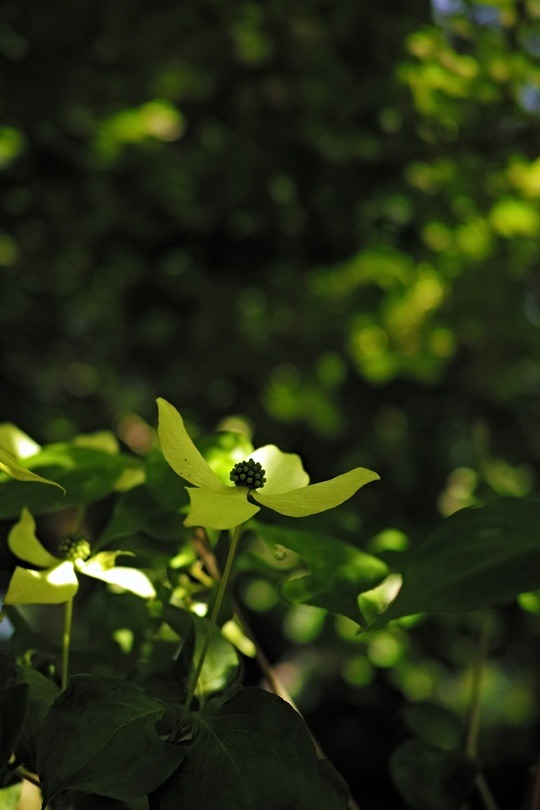
山法師[Yamabōshi]
Cornus kousa subsp. kousa
山[Yama] : Mountain
法師[-bōshi|Hōshi] : Buddhist priest
It is said to be so named that the appearance of the flower resembles the head of a Hōshi wearing a white hood. This botanical name "kousa" came from the fact that this plant was called くさ[Kusa] in a dialect of Hakone, Kanagawa Prefecture.
https://honolulumuseum.org/collections/72654/
Reading 山��師 as Yamahōshi meant lower-priests of Enryaku-ji. And 寺法師[Terahōshi] meant them of Miidera(Onjō-ji.) 寺[Tera] means temple.
https://en.wikipedia.org/wiki/Mount_Hiei
https://en.wikipedia.org/wiki/Mii-dera
5 notes
·
View notes
Text
UEFA Champions League: AC Milan återvände till topp 4 efter 16 år
Senast AC Milan-laget gick vidare till Champions League-semifinalerna var fortfarande under säsongen 2006 till 2007. De vann äntligen den sjunde Champions League-trofén i säsongens historia. Deras fans som bar billiga fotbollströja AC Milan kommer aldrig att glömma det året.
Den 18 april spelade 1/4-finalerna i Champions League säsongen 2022 till 2023 en tävling. I en "Serie Dabei" delade AC Milan-laget Neapel 1 till 1 borta och eliminerade därmed motståndaren för att gå vidare till semifinal med en totalpoäng på 2-1 i två omgångar.
Den här duellen är full av dramatik. Milans anfallare Giloo blev "huvudpersonen" i första halvlek. Han bötfällde först straffen, och gjorde sedan ett mål med ett sportspel för att "göra upp". I den andra halvleken av matchen attackerade Neapel, som hade totalt två mål bakom, men straffsparken i den 82:a minuten av Kwarashlia räddades tappert av Milan-målvakten Mii Nyon. Under sådana omständigheter, även om Neapellagets främste målskytt Osmane gjorde ett mål på stopptid, gjorde han ändå totalt 1-2 matcher.
0 notes
Photo
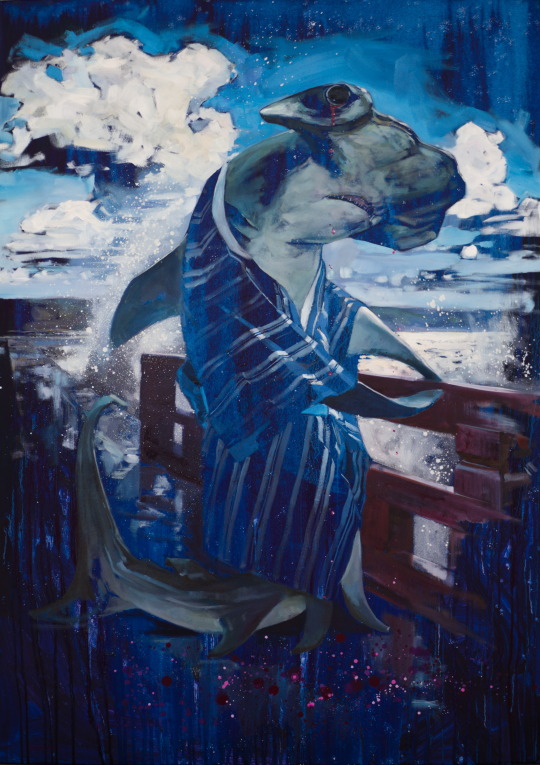
My new painting "Samebito"
oil on canvas 140x100 cm
In the story, a man named Tōtarō meets the Samebito one day on a bridge. Although frightening, the creature turns out to be a gentle being who, as punishment for a petty fault, has been expelled from the sea by his former employer Ryūjin. Tōtarō takes pity on the creature and allows it to live in a deep pond in his garden. Meanwhile, Tōtarō has been seeking a bride and eventually falls in love with a beautiful woman he sees at a female pilgrimage at Mii-dera. He becomes deathly sick with grief, however, on learning that her family requires a betrothal gift of ten thousand jewels for her hand in marriage. When the Samebito learns that his master is on his deathbed, he begins to cry tears of blood which become precious rubies when they hit the ground. Through the Samebito's tears, Tōtarō eventually wins the hand of the woman with whom he is infatuated. He went to the coast every day and wept looking at his homeland, unable to return. These precious tears he gave in gratitude to Totaro.
When he has finished weeping, the Samebito is also pardoned by the dragons, and the story ends happily.
12 notes
·
View notes
Photo
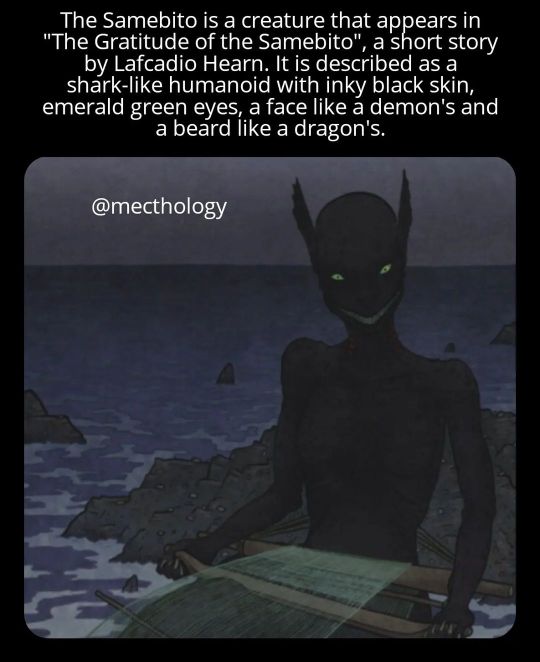
The Semebito from Japanese folklore.
In the story, a man named Tōtarō meets the Samebito one day on a bridge. Although frightening, the creature turns out to be a gentle being who, as punishment for a petty fault, has been expelled from the sea by his former employer Ryūjin. Tōtarō takes pity on the creature and allows it to live in a deep pond in his garden. Meanwhile, Tōtarō has been seeking a bride and eventually falls in love with a beautiful woman he sees at a female pilgrimage at Mii-dera. He becomes deathly sick with grief, however, on learning that her family requires a betrothal gift of ten thousand jewels for her hand in marriage. When the Samebito learns that his master is on his deathbed, he begins to cry tears of blood which become precious rubies when they hit the ground. Through the Samebito's tears, Tōtarō eventually wins the hand of the woman with whom he is infatuated. When he has finished weeping, the Samebito is also pardoned by the dragons, and the story ends happily.
Hearn notes that the name for this being is usually read as Kōjin. The kōjin are creatures thought to live in the South China Sea, which resemble ningyo, are always weaving at their looms and whose tears become jewels.
Follow @mecthology for more tales and lores. DM for pic credit or removal. https://www.instagram.com/p/CcaxW_OtedD/?igshid=NGJjMDIxMWI=
3 notes
·
View notes
Photo
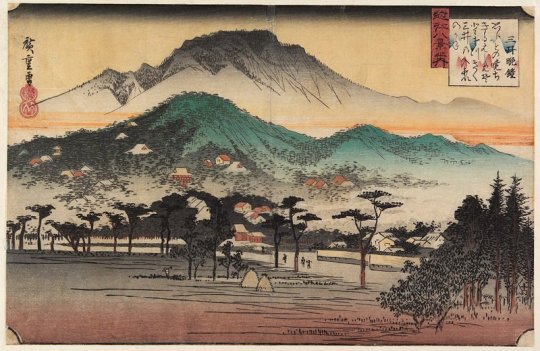
Evening Bell at Mii-dera Temple, Utagawa Hiroshige, c. 1834-1835, Minneapolis Institute of Art: Japanese and Korean Art
Miidera, also known as Onjøji, is the head temple of the Tendai sect of Buddhism. Built on a hill overlooking Lake Biwa, the temple compound consists of many buildings constructed over the temple's long history. For this print, Hiroshige depicted the temple from an unusual vantage point which shows the southern slope of the compound rather than the more famous view of the lake on the east side. He did not depict the temple's famous bell either, after which the theme of "evening bells" was named. Nonetheless, this peaceful landscape under a yellow sky conveys the serene beauty of an evening at the mountain temple, where the only sound might have been that of the bell summoning the monks to their evening devotions.
Size: 8 5/8 × 13 3/8 in. (21.9 × 34 cm) (image, sheet, horizontal ōban)
Medium: Woodblock print (nishiki-e); ink and color on paper
https://collections.artsmia.org/art/22558/
27 notes
·
View notes
Photo
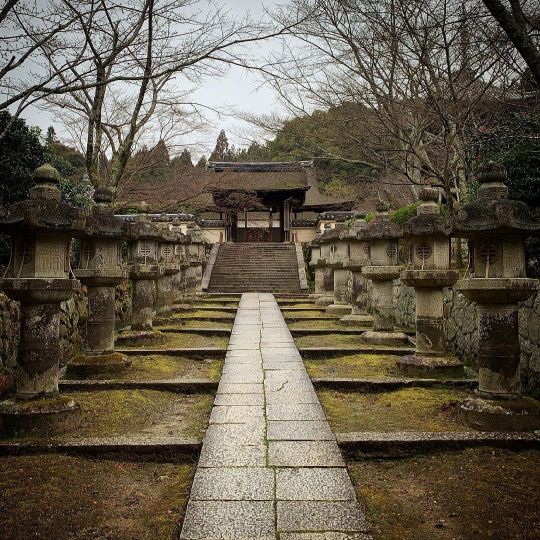
あのロケ地 (三井寺(Mii-dera)) https://www.instagram.com/p/CMd9dBTj5Q0/?igshid=mulyu8kflwgh
7 notes
·
View notes
Photo
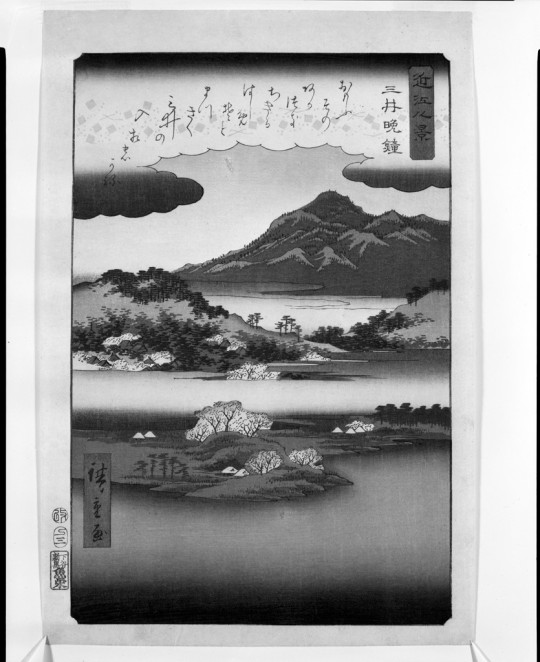
Evening Bell at Mii-dera (Mii bansho), Utagawa Hiroshige, 19th century, Harvard Art Museums: Prints
Harvard Art Museums/Arthur M. Sackler Museum, Ernest B. and Helen Pratt Dane Fund for the Acquisition of Oriental Art
Size: Paper: H. 37.9 cm x W. 25.6 cm (14 15/16 x 10 1/16 in.)
Medium: Ink and color on paper
https://www.harvardartmuseums.org/collections/object/201245
1 note
·
View note
Text

'Race at the Uji River' - the main detail of a ca. 1760s byobu screen - by Soga Shohaku (曾我蕭白, 1730 – 1781), a Japanese painter of the Edo period. From the Feinberg Collection at the MET in New York.
The picture relates to a famous historic event - the first battle of Uji (1180), significant for having began the Genpei War (源平合戦, Genpei kassen, Genpei gassen), 1180–1185, a national civil war between the Taira and Minamoto clans during the late-Heian period of Japan.
In early 1180, Prince Mochihito, the Minamoto Clan's favoured claimant to the Imperial Throne, was chased by Taira forces to the Mii-dera, a temple just outside Kyoto. Due to the interference of a Mii-dera monk with Taira sympathies, the Minamoto army arrived too late to help defend the temple.
Minamoto no Yorimasa and Prince Mochihito, along with a force of about fifteen hundred men including the warrior monks of Mii-dera and the Watanabe clan, fled south towards Nara. They crossed the Uji River, just outside the Byōdō-in, and tore up the planks of the bridge behind them to prevent the Taira from following.
Three warrior monks in particular are named in the "Heike Monogatari": Gochi-in no Tajima, Tsutsui Jōmyō Meishū, and Ichirai Hōshi. These three, along with the other monks of Mii-dera, fought with bow and arrow, a variety of swords, daggers and naginata.
As for the Taira troops, they were led by Ashikaga Tadatsuna, one of the few warriors of direct Minamoto descent who stayed loyal to his oath to the Taira family up until he and his father were murdered by one of their retainers, Kiryū Rokurō.
According to Azuma Kagami, the 18-year-old Tadatsuna is supposedly remembered as having had the strength of one hundred men, a voice that echoed over 10 li (5 km), and teeth of 1 sun (3.03 cm) long. Further stating that "there will be no warrior in future ages like this Tadatsuna"!
Led by their young general, the Taira force soon began to ford the river and caught up with the Minamoto. Tadatsuna was the first warrior on the frontline and following a custom of the period is said to have proclaimed his name and lineage before charging his enemies. Yorimasa tried to help the Imperial Prince get away, but was struck with an arrow in the right elbow. While his sons, Nakatsuna and Kanetsuna were fighting to fend off their enemies, Yorimasa committed seppuku. Meanwhile Prince Mochihito was captured and killed shortly after the battle by the Taira clan.
6 notes
·
View notes
Video
Onjō-ji. Mii-dera temple by DanÅke Carlsson
#Japan#Japanese#Shiga#Ōtsu#Onjō-ji#Mii-dera#tempo#Buddhism#religion#traditional#building#hall#photography
0 notes
Photo
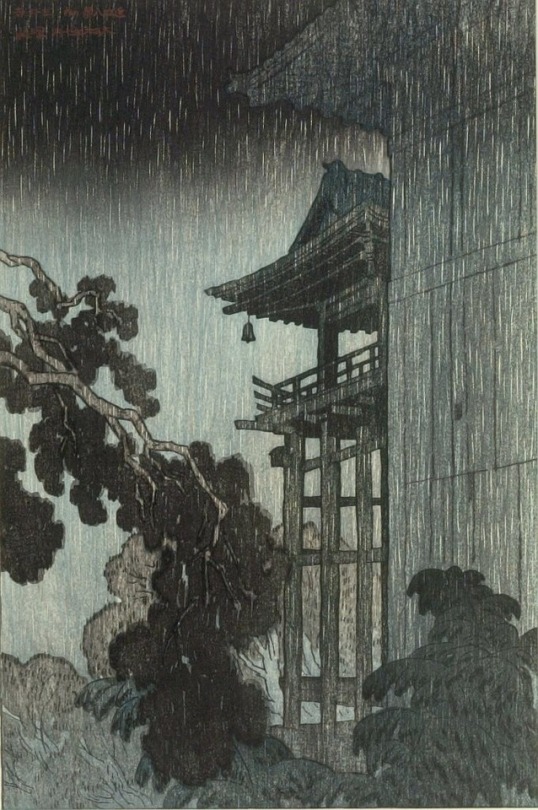
Artist: Ito Shinsui
Title: Mii-dera, from the series Eight Views of Lake Biwa (ômi hakkei), 1917
828 notes
·
View notes
Photo

Onjō-ji (Mii-dera), Otsu, Shiga
4 notes
·
View notes

